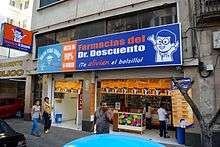Separation of prescribing and dispensing
Separation of prescribing and dispensing, also called dispensing separation, is a practice in medicine and pharmacy in which the physician who provides a medical prescription is independent from the pharmacist who provides the prescription drug.
In the Western world there are centuries of tradition for separating pharmacists from physicians. In Asian countries it is traditional for physicians to also provide drugs.
In contemporary time researchers and health policy analysts have more deeply considered these traditions and their effects. Advocates for separation and advocates for combining make similar claims for each of their conflicting perspectives, saying that separating or combining reduces conflict of interest in the healthcare industry, unnecessary health care, and lowers costs, while the opposite causes those things. Research in various places reports mixed outcomes in different circumstances.
Background
In jurisdictions (such as the United States), pharmacists are regulated separately from physicians. These jurisdictions also usually specify that only pharmacists may supply scheduled pharmaceuticals to the public, and that pharmacists cannot form business partnerships with physicians or give them "kickback" payments. In other words, the diagnosing physicians' role is supposed to extend only as far as providing proper prescriptions to patients, who are then entitled to purchase the prescribed drugs at the pharmacies of their choice.[1]
However, the American Medical Association (AMA) Code of Ethics provides that physicians may dispense drugs within their office practices as long as there is no patient exploitation and patients have the right to a written prescription that can be filled elsewhere. 7 to 10 percent of American physicians practices reportedly dispense drugs on their own.[2]
In some rural areas in the United Kingdom, there are dispensing physicians[3] who are allowed to both prescribe and dispense prescription-only medicines to their patients from within their practices. The law requires that the GP practice be located in a designated rural area and that there is also a specified, minimum distance (currently 1 mile; 1.6 kilometres) between a patient's home and the nearest retail pharmacy. See Dispensing Doctors' Association.
This law also exists in Austria for general physicians if the nearest pharmacy is more than 4 kilometers (2½ miles) away, or where none is registered in the city. Switzerland also allows dispensing physicians in several Kantons..[4]

In other jurisdictions (particularly in Asian countries such as China, Malaysia, and Singapore), doctors are allowed to dispense drugs themselves and the practice of pharmacy is sometimes integrated with that of the physician, particularly in traditional Chinese medicine.
In Canada it is common for a medical clinic and a pharmacy to be located together and for the ownership in both enterprises to be common, but licensed separately.
The reason for the majority rule is the high risk of a conflict of interest and/or the avoidance of absolute powers. Otherwise, the physician has a financial self-interest in "diagnosing" as many conditions as possible, and in exaggerating their seriousness, because he or she can then sell more medications to the patient. Such self-interest directly conflicts with the patient's interest in obtaining cost-effective medication and avoiding the unnecessary use of medication that may have side-effects. This system reflects much similarity to the checks and balances system of the U.S. and many other governments.
A campaign for separation has begun in many countries and has already been successful (as in Korea). As many of the remaining nations move towards separation, resistance and lobbying from dispensing doctors who have pecuniary interests may prove a major stumbling block (e.g. in Malaysia).
Experience in Asian countries
In many Asian countries there is not a traditional separation between physician and pharmacist.[5] In Taiwan, a plan initiated in March 1997 experimented with separating doctors who prescribe from pharmacists who fulfill prescriptions on the theory that this would reduce unnecessary health care.[5] The plan had mixed results.[5] The South Korean government passed a law in 2000 which separated drug prescribing from dispensing.[6] The passing of the law achieved some of its intentions and also caused problems in unexpected ways.[6] Japan also is experimenting with separation of prescribing and dispensing.[7] In Malaysia, as of 2016, separation of prescribing and dispensing only occurs in government hospitals.[8]
References
- Latham, Stephen R. (2001). "Conflict of Interest in Medical Practice". In Davis, Michael; Stark, Andrew (eds.). Conflict of Interest in the Professions. Oxford: Oxford University Press. pp. 279–301. ISBN 9780195344073. Retrieved 10 August 2020.
- American Association of State Compensation Insurance Funds, Prepackaged Drugs in Workers' Compensation
- British Medical Association, briefing on dispensing doctors, 30 January 2009
- Der Hausarzt, [https://www.patientenapotheke.ch/uploads/wirtschaftlich-patientenfreundlich.pdf Wirtschaftlich und patientenfreundlich - In der Schweiz geben Ärzte selbst Medikamente ab]
- Chou, YJ; Yip, WC; Lee, CH; Huang, N; Sun, YP; Chang, HJ (September 2003). "Impact of separating drug prescribing and dispensing on provider behaviour: Taiwan's experience". Health Policy and Planning. 18 (3): 316–29. doi:10.1093/heapol/czg038. PMID 12917273.
- Kwon, S (August 2003). "Pharmaceutical reform and physician strikes in Korea: separation of drug prescribing and dispensing". Social Science & Medicine. 57 (3): 529–38. doi:10.1016/s0277-9536(02)00378-7. PMID 12791494.
- Yokoi, M; Tashiro, T (7 April 2014). "Influence of the separation of prescription and dispensation of medicine on its cost in Japanese prefectures". Global Journal of Health Science. 6 (4): 57–62. doi:10.5539/gjhs.v6n4p57. PMC 4825256. PMID 24999122.
- Tiong, JJ; Mai, CW; Gan, PW; Johnson, J; Mak, VS (August 2016). "Separation of prescribing and dispensing in Malaysia: the history and challenges". The International Journal of Pharmacy Practice. 24 (4): 302–5. doi:10.1111/ijpp.12244. PMID 26777986.
Further reading
Trap, B (1997). "Practices of dispensing doctors - drug use and health economics". archives.who.int. World Health Organization. Retrieved 14 February 2017.
External links
- Dispensing Separation: Making the Sick Pay More, 3-minute video drama presenting the concept of dispensing separation as tragedy and horror